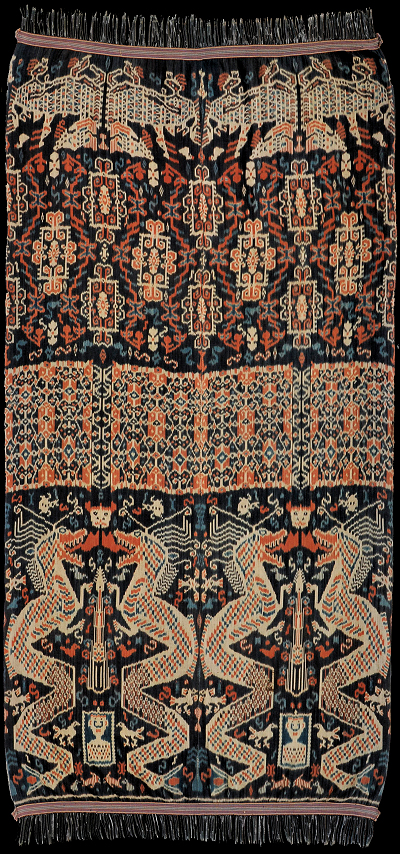| |
 
 | | | |
017 Sumba, East Sumba
Hinggi (men's blanket)  
| | Locale: | Probably Kanatang. | | Period: | 1970s | | Yarn: | Cotton, commercial, fine, double-ply | | Technique: | Warp ikat | | Panels: | 2 | | Size: | 123 x 255 cm (4' 0" x 8' 4") LW: 2.07 | | Weight: | 875 g (30.9 oz), 279 g/m2 (0.91 oz/ft2) | | Design: | Example of the pagi-sore style briefly produced in the 1970s and 1980s for textile art collectors in Indonesia and abroad. The Sumbanese technical term for its construction is hondu kihhil. The two panels are identical, and both are symmetric longitudinally, but not axially: the top and bottom are patently different. This type of construction requires twice as much labour as a regular hinggi. The bottom half of this example, which was probably made at the court of Kanatang, carries large naga, dragons, inspired by the decorations on antique Chinese ceramics. Hemmed in between are framed small portraits representing a Dutch queen, almost certainly Wilhelmina, and sceptres. Various small animals, such as birds (probably partridges, ayam hutan), flying fruit bats, kelelawar, turtles, snakes and ducks serve as fillers. The top half carries framed variants of the habaku motif which used to be reserved for royalty, and what appear to be pairs of lions in opposition. Here again, small animals are used as fillers.The centrefield is decorated with a complex and immaculately executed patola ratu pattern inspired by patola motifs, likewise formerly the exclusive prerogative of the nobility. An interesting aspect of the centrefield's design is the presence of hidden asymmetry-producing elements. While the pagi-sore design immediately evinces that top and bottom half are entirely different, the dyer also made several small deviations from regularity in the patola ratu pattern that by themselves also create axial asymmetry. | | Comment: | The approximate number of bindings required to create this work of textile art was calculated by counting the number of colour changes contained in a half a dozen 10 x 10 cm samples. The estimate for the cloth as a whole came to 10,000, a number that speaks volumes about the commitment of time and energy invested in this sophisticated modern hinggi.
Some of the devices creating axial asymmetry are so easy to overlook that they reveal knowledge of the old techniques to create axial asymmetry without seeming to. This suggests manufacture by an 'old school' dyer, perhaps one of the last to still possess or at least employ such knowledge. The present author has encountered precious few of such manifestations of legacy techniques to create axial asymmetry in hinggi made after the 1940s. � | | Background: | Chapters on Sumba and East Sumba. | | Published: | Noble Virtuosity: Hidden Asymmetry in Ikat from Sumba, 2024. | | Compare: | 044 096 | | Sources: | Cf. hinggi depicted in Gittinger, Splendid Symbols, Fig. 120. Similar design, though ours clearly has far superior detailing. The same applies to pagi-sore hinggi in Barry Dawson, Traditional Indonesian Textiles, Fig. 96. | | |

©Peter ten Hoopen, 2025
All rights reserved.
|
|


